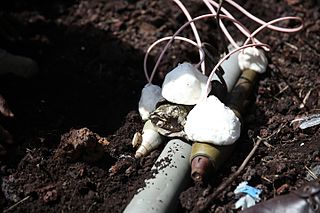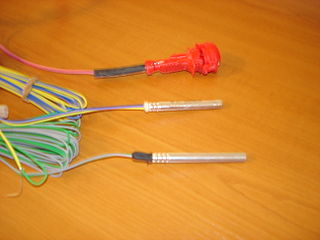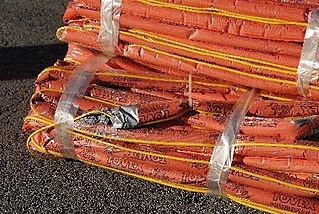
Dynamite is an explosive made of nitroglycerin, sorbents, and stabilizers. It was invented by the Swedish chemist and engineer Alfred Nobel in Geesthacht, Northern Germany, and patented in 1867. It rapidly gained wide-scale use as a more robust alternative to black powder.

An explosive is a reactive substance that contains a great amount of potential energy that can produce an explosion if released suddenly, usually accompanied by the production of light, heat, sound, and pressure. An explosive charge is a measured quantity of explosive material, which may either be composed solely of one ingredient or be a mixture containing at least two substances.

Plastic explosive is a soft and hand-moldable solid form of explosive material. Within the field of explosives engineering, plastic explosives are also known as putty explosives or blastics.

Pentaerythritol tetranitrate (PETN), also known as PENT, PENTA, TEN, corpent, or penthrite, is an explosive material. It is the nitrate ester of pentaerythritol, and is structurally very similar to nitroglycerin. Penta refers to the five carbon atoms of the neopentane skeleton. PETN is a very powerful explosive material with a relative effectiveness factor of 1.66. When mixed with a plasticizer, PETN forms a plastic explosive. Along with RDX it is the main ingredient of Semtex.

A detonator, frequently a blasting cap, is a device used to trigger an explosive device. Detonators can be chemically, mechanically, or electrically initiated, the last two being the most common.

C-4 or Composition C-4 is a common variety of the plastic explosive family known as Composition C, which uses RDX as its explosive agent. C-4 is composed of explosives, plastic binder, plasticizer to make it malleable, and usually a marker or odorizing taggant chemical. C-4 has a texture similar to modelling clay and can be molded into any desired shape. C-4 is relatively insensitive and can be detonated only by the shock wave from a detonator or blasting cap.

ANFO ( AN-foh) (or AN/FO, for ammonium nitrate/fuel oil) is a widely used bulk industrial explosive. It consists of 94% porous prilled ammonium nitrate (NH4NO3) (AN), which acts as the oxidizing agent and absorbent for the fuel, and 6% number 2 fuel oil (FO). The use of ANFO originated in the 1950s.
Detasheet is a flexible rubberized explosive, somewhat similar to plastic explosives, originally manufactured by DuPont. Its ingredients are PETN with nitrocellulose and a binder.
A Bangalore torpedo is an explosive charge placed within one or several connected tubes. It is used by combat engineers to clear obstacles that would otherwise require them to approach directly, possibly under fire. It is sometimes colloquially referred to as a "Bangalore mine", "banger" or simply "Bangalore" as well as a pole charge.

Detonating cord is a thin, flexible plastic tube usually filled with pentaerythritol tetranitrate. With the PETN exploding at a rate of approximately 6,400 m/s (21,000 ft/s), any common length of detonation cord appears to explode instantaneously. It is a high-speed fuse which explodes, rather than burns, and is suitable for detonating high explosives. The detonation velocity is sufficient to use it for synchronizing multiple charges to detonate almost simultaneously even if the charges are placed at different distances from the point of initiation. It is used to reliably and inexpensively chain together multiple explosive charges. Typical uses include mining, drilling, demolitions, and warfare.

In an explosive, pyrotechnic device, or military munition, a fuse is the part of the device that initiates function. In common usage, the word fuse is used indiscriminately. However, when being specific, the term fuse describes a simple pyrotechnic initiating device, like the cord on a firecracker whereas the term fuze is used when referring to a more sophisticated ignition device incorporating mechanical and/or electronic components, such as a proximity fuze for an M107 artillery shell, magnetic or acoustic fuze on a sea mine, spring-loaded grenade fuze, pencil detonator, or anti-handling device.

The Ensign-Bickford Aerospace & Defense Company is a manufacturer of hardware and energetic systems for use in spacecraft, military, and industrial applications. It is a wholly owned subsidiary of Ensign-Bickford Industries.

Tannerite is a brand of binary explosive targets used for firearms practice and sold in kit form. The targets comprise a combination of oxidizers and a fuel, primarily aluminium powder, that is supplied as two separate components that are mixed by the user. The combination is relatively stable when subjected to forces less severe than a high-velocity bullet impact. A hammer blow, the product being dropped, or impact from a low-velocity bullet or shotgun blast will not initiate a reaction. It is also designed to be non-flammable, although its explosion can ignite flammable material.
Nonel is a shock tube detonator designed to initiate explosions, generally for the purpose of demolition of buildings and for use in the blasting of rock in mines and quarries. Instead of electric wires, a hollow plastic tube delivers the firing impulse to the detonator, making it immune to most of the hazards associated with stray electric current. It consists of a small diameter, three-layer plastic tube coated on the innermost wall with a reactive explosive compound, which, when ignited, propagates a low energy signal, similar to a dust explosion. The reaction travels at approximately 2,000 m/s (6,500 ft/s) along the length of the tubing with minimal disturbance outside of the tube. The design of nonel detonators incorporates patented technology, including the Cushion Disk (CD) and Delay Ignition Buffer (DIB) to provide reliability and accuracy in all blasting applications.

Tovex is a water-gel explosive composed of ammonium nitrate and methylammonium nitrate that has several advantages over traditional dynamite, including lower toxicity and safer manufacture, transport, and storage. It has thus almost entirely replaced dynamite. There are numerous versions ranging from shearing charges to aluminized common blasting agents. Tovex is used by 80% of international oil companies for seismic exploration.

Dyno Nobel is a manufacturer of explosives. It is a wholly owned subsidiary of Incitec Pivot Limited operating in Australia, Canada, the United States, Africa, Indonesia, Mexico, South America, Papua New Guinea and Turkey.
Explosive materials are produced in numerous physical forms for their use in mining, engineering, or military applications. The different physical forms and fabrication methods are grouped together in several use forms of explosives.
The safety fuse is a type of fuse invented and patented by English inventor William Bickford in 1831. Originally it consisted of a "tube" of gunpowder surrounded by a waterproofed varnished jute "rope." It replaced earlier and less reliable methods of igniting gunpowder blasting charges which had caused many injuries and deaths in the mining industry. The safety fuse burns at a rate of typically about 30 seconds per foot.
A shock tube detonator is a non-electric explosive fuze or initiator in the form of small-diameter hollow plastic tubing used to transport an initiating signal to an explosive by means of a shock wave traveling the length of the tube. Shock tube is used to convey a detonation signal to a detonator. Shock tube is a hollow extruded tube containing a thin layer of energetic material upon its inner diameter. Once it is initiated, the shock tube transfers a signal to a detonating output charge.
Staged detonation is an overall principle used for many explosive devices. A general description of the principle is that one explosive compound with one set of properties is detonated, and the detonation wave from this is transfers into another explosive compound with different set of properties.












